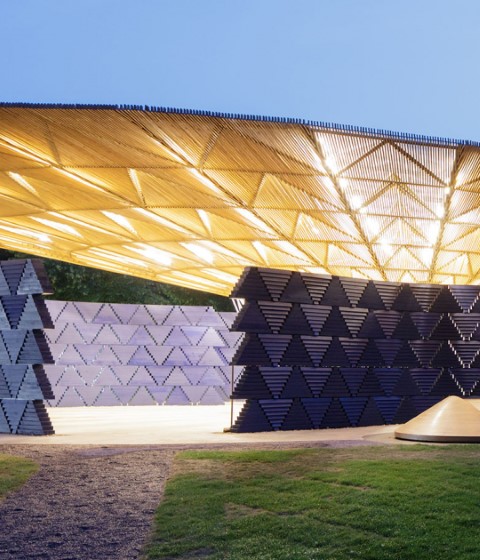The logs also drop down from the ceiling in alternating lengths and densities in order to shape the occupation of the space while also allowing dappled light to filter into the pavilion.
In keeping with the educational mission of Tippet Rise, the Tippet Rise Fund of the Sidney E. Frank Foundation is supporting Francis Kéré in building environmentally sustainable and climatically appropriate schools in West Africa by funding the construction of a new school he has designed in his birthplace, the village of Gando in Burkina Faso.
Opening in January 2020, the Naaba Belem Goumma Secondary School will accommodate approximately 1,000 students. More details about the school, which is named for Kéré’s father, are available here.
On a 4,860-Ha working sheep and cattle ranch just outside of Fishtail, Cathy and Peter Halstead, through their family’s Sidney E. Frank Foundation, established the music and visual arts center Tippet Rise against the dramatic natural backdrop. The property is home to large-scale works by Ensamble Studio, Mark di Suvero, Alexander Calder, Isabelle Johnson, and others.
Description of project by Francis Kéré
Xylem, the gathering pavilion for the Tippet Rise Art Center, has been designed by Francis Kéré as a quiet, protective shelter for the visitors of the ranch. Named to evoke the vital internal layers of a tree’s living structure, Xylem is a place where visitors may gather to converse, contemplate the views of the aspen and cottonwood trees near the bank of Grove Creek, or sit and meditate in solitude.
Located in a slightly sunken landform between the main facilities of the Art Center and the beginning of the hiking tracks, the pavilion rises in a clearing surrounded by aspen trees, facing a small creek. Entirely carved in wooden logs, the pavilion symbolically invites the visitor, who in the Tippet Rise Art Center is confronted with nature at its widest scale, to access the most secret part of nature, the heart of the trees. The sustainable pine wood used for the entire pavilion, locally sourced from a natural pruning process that saves forests from parasitic bugs, is employed in its raw appearance.
The logs of the canopy are assembled in circular bundles bore by a modular hexagonal structure in weathering steel, lying on top of seven steel columns. The upper surface of the canopy is carved sinuously in order to create a rounded topography that blends in the surrounding hills. At the same time massive and light, the roof is inspired by the “toguna”, the traditional most sacred space in every Dogon village, a wooden and straw shelter designed in order to protect from the sun but at the same time to allow the ventilation of the shaded space underneath.
In the pavilion, sunbeams penetrate between the vertical logs, creating a play of light and shadow that softly hits the underlying organically shaped seating and the polished concrete circular platform. The spatial complexity of the carved wooden seating elements emphasizes the stunning views of the surrounding landscape through strategic positions and encourages different appropriations by the visitor, who is invited to inhabit them at his wish. Through exploration, the user can, in fact, discover the different spatial configurations of the pavilion, gather in small groups or have a chat between friends, lie and watch the romantic views with his partner, or sit and meditate in solitude on his visit of the Art Center.
Xylem welcomes visitors and the whole community that revolves around the Tippet Rise Art Center to a unique linkage between Montana and Burkina Faso as it is built in parallel with the Naaba Belem Goumma Secondary School in Gando, Francis Kéré’s home village in Burkina Faso, dedicated to Francis Kéré’s father, which will be open to the children of the entire neighboring area in the Burkinabè savannah.

































